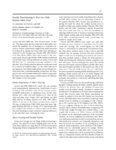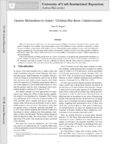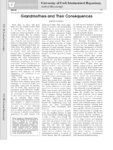|
|
Creator | Title | Description | Subject | Date |
| 26 |
 |
McCullough, John M. | Evidence for assortative mating and selection in surnames: a case from Yucatan, Mexico | Surnames are often used as metaphors for genetic material on the assumption of neutrality and general immunity from systematic pressures. The Yucatec Maya use surnames of both Maya and Spanish origin. We find evidence of positive assortative mating by ethnic origin of surname and a slight bias away ... | Surnames; Assortative mating; Maya | 1985 |
| 27 |
 |
Rogers, Alan R. | Evolution of time preference by natural selection | This paper entertains the hypothesis that human time preferences are in evolutionary equilibrium (i.e. that no mutation changing time preferences could be favored by natural selection). This hypothesis implies that the marginal rate of substitution (MRS) holding Darwinian fitness constant must equal... | Capitalism; Econometric models; Equilibrium | 1994-06 |
| 28 |
 |
Codding, Brian F. | Explaining prehistoric variation in the abundance of large prey: a zooarchaeological analysis of deer and rabbit hunting along the Pecho Coast of Central California | Three main hypotheses are commonly employed to explain diachronic variation in the relative abun dance of remains of large terrestrial herbivores: (1) large prey populations decline as a function of anthro pogenic overexploitation; (2 ) large prey tends to increase as a result of increasing social p... | Foraging; Resource depression; Prestige hunting; Paleoclimatic variability; Human behavioral ecology; Zooarchaeology; Central California | 2009-11-14 |
| 29 |
 |
Codding, Brian F. | External impacts on internal dynamics: Effects of paleoclimatic and demographic variability on acorn exploitation along the Central California coast | Research into human-environment interaction in California prehistory often focuses on either the internal dynamics of adaptive decisions or the external impacts of environmental change. While both processes were surely driving prehistoric variability, integrating these approaches is not altogether s... | Acorn exploitation; Prehistoric land use; Behavioral ecology | 2016 |
| 30 |
 |
Hawkes, Kristen | Family provisioning is not the only reason men hunt | Gurven and Hill (2009) ask, "Why do mean hunt?" As they say, "The observation that mean hunt and women gather supported the simplistic view of marriage as a cooperative enterprise. Greater sophistication suggests that males may often be motivated by mating and status rather than offspring investment... | | 2010-01-01 |
| 31 |
 |
Broughton, John | Fish remains dominate Barn Owl pellets in northwestern Nevada | The foraging ecology of the Barn Owl (Tytoalba) has been studied extensively, both in the New World (Marti 1988, Castro and Jaksic 1995, Van Vuren and Moore 1998, and others) and the Old World (Glue 1967, Yom-Tov and Wool 1997, and others). Small rodents, insectivores, and small birds are generally ... | Barn Owl pellets; Northwestern Nevada; Fish; Fish remains | 2006 |
| 32 |
 |
Hawkes, Kristen | Food sharing among Ache hunter-gatherers of Eastern Paraguay | Empirical research on food sharing among hunter-gatherers should provide critical data for evaluating both the possible role of food sharing in hominid evolution and the question of how such behavior could be selected. | Hunter-gatherers; Ache; Paraguay; Anthropology | 1988-02 |
| 33 |
 |
Rogers, Alan R.; Jorde, Lynn B. | Founder effect: assessment of variation in genetic contributions among founders | We present a Monte Carlo method for determining the distribution of founders' genetic contributions to descendant cohorts. The simulation of genes through known pedigrees generates the probability distributions of contributed genes in recent cohorts of descendants, their means, and their variances. | | 1994 |
| 34 |
 |
Rogers, Alan R. | Genetic evidence for a Pleistocene population explosion | Expansions of population size leave characteristic signatures in mitochondrial "mismatch distributions." Consequently, these distributions can inform us about the history of changes in population size. Here, I study a simple model of population history that assumes that, t generations before the pr... | | 1995 |
| 35 |
 |
Rogers, Alan R.; Jorde, Lynn B. | Genetic evidence on modern human origins | A review of genetic evidence leads to the following conclusions concerning human population history: (1) Between 33,000 and 150,000 years ago the human population expanded from an initial size of perhaps 10,000 breeding individuals, reaching a size of at least 300,000. (2) Although the initial popu... | Population history; Mitochondrial DNA; Mismatch distribution; Intermatch distribution; Replacement hypothesis; Population bottlenecks | 1995 |
| 36 |
 |
Rogers, Alan R. | Genetic relatedness to sisters children has been underestimated | Males of many species help in the care and provisioning of offspring, and these investments often correlate with genetic relatedness. For example, many human males invest in the children of sisters, and this is especially so where men are less likely to share genes with children of wives. Although t... | | 2013-01-01 |
| 37 |
 |
Rogers, Alan R.; Harpending, Henry C. | Genetic structure of ancient human populations | Discusses mitochondrial DNA (mtDNA) sequences as important source of data about the history of human species. | Tree of descent; Mismatch distributions; Simulations; Findings; Intermatch distributions; Younger and older populations | 2001-09-15 |
| 38 |
 |
Rogers, Alan R.; Jorde, Lynn B. | Genetic structure of the Utah Mormons: comparison of results based on RFLPs, blood groups, migration matrices, isonymy, and pedigrees | The genetic structure of the Utah Mormon population is examined using 25 blood group and 47 RFLP alleles obtained from 442 subjects living in 8 geographic subdivisions. Nei's Gst was 0.013 (p < 0.002) for the RFLP data and 0.012 (p > 0.4) for the blood group data, showing that only 1% of the geneti... | | 1994 |
| 39 |
 |
Rogers, Alan R. | Genetic variation at the MCIR Locus and the time since loss of human body hair | The melanocortin I receptor (MCIR) locus makes a protein that affects the color of skin and hair. At this locus, amino-acid differences are entirely absent among African humans, abundant among non-Africans (especially Europeans), and abundant in chimpanzee/human comparisons (Rana et al. 1999, Hardin... | Nonsynonymous; Chimpanzee; Constraint | 2004 |
| 40 |
 |
Hawkes, Kristen; O'Connell, James F. | Global process and local ecology: how should we explain differences between the Hadza and the !Kung? | In this chapter we discuss explanations for the diversity of behavior of contemporary forager populations. Other contributors document variation among southern African savanna Bushman groups, and central African forest Pygmies. We confine ourselves to trying to explain some differences between two ... | | 1996 |
| 41 |
 |
Hawkes, Kristen | Grandmothers and their consequences | Both what we share and don't share with our primate cousins make us human. Easy enough to start a list. At least since Darwin, most would rate moral sentiments as distinctively human. But our modern selves didn't emerge from ancestral apes in one step. When did populations along the way become human... | | 2012-01-01 |
| 42 |
 |
Rogers, Alan R. | Group selection by selective emigration: the effects of migration and kin structure | Group selection may operate through selective emigration, as Sewall Wright envisioned, as well as through selective extinction. The discrete-generation model of selective emigration developed here yields the following conclusions. 1. The fitness benefit of altruism, "depends on the frequency of altr... | Natural selection; Selective extinction; Evolution | 1990-03 |
| 43 |
 |
Hawkes, Kristen | Hadza children's foraging: juvenile dependency, social arrangement and mobility among hunter-gatherers | Presents a study on the foraging activities of Hadza children in Tanzania, Africa. Success of children's foraging; Determinants of children's foraging; Monitoring of the activities of children; Near-camp foraging return rates; Variables underlying the patterns of foraging. | Children; Foraging; Hazda; Hunter-gatherers | 1995 |
| 44 |
 |
Hawkes, Kristen | Hadza scavenging: implications for Plio/Pleistocene Hominid subsistence | The frequent association of stone tools and large animal bones in African Plio/Pleistocene archaeological sites has long been taken as evidence of the importance of hunting in early hominid diets. Many now argue that it reflects hominid scavenging, not hunting. | Hadza; Scavenging; Plio/Pleistocene; Hominid Diet | 1988-04 |
| 45 |
 |
Hawkes, Kristen | Hadza women's time allocation, offspring provisioning, and the evolution of long postmenopausal life spans | Extended provisioning of offspring and long postmenopausal life spans are characteristic of all modern humans but no other primates. These traits may have evolved in tandem. Analysis of relationships between women's time allocation and children's nutritional welfare among the Hadza of northern Tanza... | Child care; Children, nutrition; Life spans, Biology; Mother & child; Primates; Social structure; Women; Time Management; Hominids | 1997 |
| 46 |
 |
Broughton, John | Homestead cave Ichthyofauna | Biological evidence on the climatic and hydrographic history of the intermountain region would be much richer, if we had more than the present dribble of paleontological data on the fishes (Hubbs and Miller, 1948, p. 25). In this passage from their landmark synthesis of historical fish biogeograph... | Homestead Cave; Ichthyofauna; Lake Bonneville | 2000 |
| 47 |
 |
Rogers, Alan R. | How much can fossils tell us about regional continuity? | Presents a study on the genetic contribution of earlier populations to later populations within regions called regional continuity. Testing for regional continuity with multiple characters; Replacement of archaic population by a population of modern humans. | Human genetics; Fossils; Regional continuity | 2006-06-05 |
| 48 |
 |
Cashdan, Elizabeth A. | How women compete | Men are more physically aggressive and more risk-prone than women, but are not necessarily more competitive. New data show the gender difference in competitiveness to be one of kind rather than degree, with women and men competing in different ways and, to some extent, over different objectives, but... | Gender differences, behavior; Competition; Aggression | 1999-06 |
| 49 |
 |
O'Rourke, Dennis H. | Hrdlič̌ka's Aleutian population-replacement hypothesis: a radiometric evaluation | In a 1945 monograph, Hrdlička argued that, at 1,000 BP, Paleo-Aleut people on Umnak Island were replaced by Neo-Aleut groups moving west along the island chain. His argument was based on cranial measurements of skeletal remains from Chaluka Midden and mummified remains from Kagamil and Ship Rock b... | Population replacement; Paleo-Aleuts; Neo-Aleuts | 2006 |
| 50 |
 |
Hawkes, Kristen | Human life histories: primate trade-offs, grandmothering socioecology, and the fossil record | Human life histories differ from those of other animals in several striking ways. Recently Smith and Tompkins (1995, p. 258) highlighted the combination of "slow" and "fast" features of human lives. Our period of juvenile dependency is unusually long, our age at first reproduction is late, and we h... | Meat; Maturity; Life Span | 2003 |

























